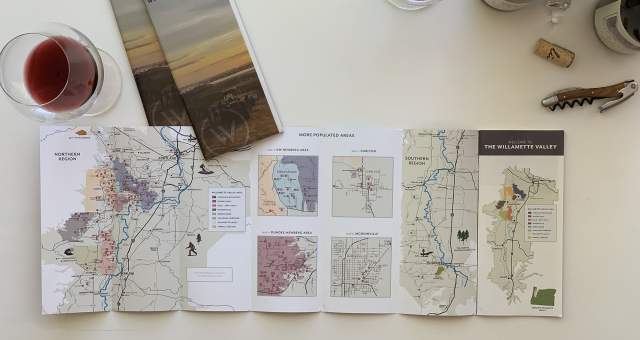What’s Vintage Variation, and Why Does It Matter?
Do you remember what the weather was like the year you graduated from high school? Perhaps not, but you probably remember the number-one hit song, the name of your crush, and whether you had access to a car. So much can happen over the course of a year, and yet something as seemingly routine as a vintage statement on a wine label may be easy to overlook. But that single piece of information is an amazing invitation to delve a little deeper and connect with the stories and circumstances of a given year––particularly if the bottle comes from a region like the Willamette Valley.
Some of the world’s winegrowing regions are fairly predictable from one vintage to the next, with few unforeseen weather events or extremes. Other regions have noticeable differences in weather and conditions each year, due to their geographic location and characteristics of their landscape such as mountains and ocean proximity. The Willamette Valley is in the latter category, and winemakers refer to this year-on-year change as vintage variation.
A Welcome Challenge
The challenges of making wine in a region with vintage variation are evident: rather than managing predictable weather patterns, vineyard managers and winemakers must react to growing conditions that can vary widely, from bud break in the spring to the last harvest day in the fall. They deal with unexpected rain, unprecedented heat waves, late spring frost and early autumn hail, just to name a few surprises. Winegrowers in these regions tend to be fond of the old saying that if you want to make the gods laugh, just tell them your plan.
Yet they also embrace and seek out such places. Why? One of the most important skills in this profession is the ability to adapt to changing conditions. Real-world experience is critical, and great growers and winemakers sometimes have to reject conventional wisdom in order to respond to the vineyard and the grapes in front of them. Vintage variation tests this skill. Highly vintage-variable regions can be unforgiving––but for some, that’s part of the appeal.
“I enjoy the vintage variation we are gifted here in Oregon. We aren’t making Coca-Cola, where every year has to be exactly the same to entice our followers,” says winemaker Wynne Peterson-Nedry of RR Wines. “Having lived in Oregon most of my life, I know that trying to predict a vintage and expecting anything in particular before picking has arrived is futile,” she explains. “I embrace the changes we have from year to year; I enjoy finding a new balance in the wines each year, and making the best representation of our growing season with each new vintage.”
Vintage 2022: The Outlook
The 2022 vintage did not make a quiet entrance. Frost struck the region in April, causing damage to some of the tender buds that were just beginning to burst. The affected vines needed to then produce secondary and tertiary buds, which takes time and shifts the growing season later to allow the newer buds a sufficient number of sunny and warm days. In September, when harvest would normally be ramping up across the Valley, many producers have been waiting at least two weeks later than usual to pick their grapes.
Harvesting later means facing cooler and potentially wetter conditions. “Challenges with later harvests here in the Willamette Valley always involve weather (and mental fortitude!),” says winemaker Anna Matzinger of Matzinger Davies. “Will some rains come and temperatures drop? Yes, eventually, but if vines and sites are resilient and set up for success, later vintages in my view are often the best.” The opportunity for flavors and tannins to ripen in a cool environment is ideal for delicate varieties like Pinot noir, and a signature feature of many of the classic Willamette Valley vintages.
Matzinger has a theory about this. “Vines want to produce enticing, delicious fruit––that's their biological imperative, so that birds will consume the berries and the seeds will end up somewhere else, thus propagating the species,” she explains. With sunny, warm weather, vines can easily produce sugar and fruity flavors with “a lot of sunshine in the glass,” whereas when it's cooler and less sunny, “the vines have to dig deep to become delectable.” This produces more concentration and complexity, key markers of wine quality and, Matzinger believes, age-worthiness. “The loud voice of fruit starts to share the stage with greater complexity from notes of flowers, spice and earth, and the retained natural acidity can hold it all together like a taut string on a tuned guitar.”
Creating Snapshots
The variability in Willamette Valley winegrowing, Peterson-Nedry believes, is as rewarding for wine lovers as it is for winemakers. “I think each winemaker’s individual palate and preferences really show through with the annual variation,” she says, creating an opportunity for collectors to stock up and compare years and producers. “Vintage variation is almost a practice in memorabilia, creating snapshots of years past, and I think it’s an amazing way to preserve and enjoy a little piece of history in the present.”
With a later harvest across the Valley, winemakers have been taking the unusual opportunity to enjoy industry events, celebrate fall birthdays––or, in the case of Brick House Wines’ Doug Tunnell, double down on the harvest experience with a trip to Burgundy. “There’s no question we have a lot to learn here, but I really think the motivation is something more than just picking up tips on managing fruit or the latest new equipment,” says Tunnell, who arrived in Burgundy in late August along with assistant winemaker Savannah Mills. “We can read books about what wine means to Burgundy, but there’s just no substitute for getting a glimpse of 1,100 years of wine culture during a harvest morning beneath the spires of the Cote d’Or.”
He adds, “I sometimes think those glimpses are a time machine, offering a peek into what may lie ahead as our own Valley embraces wine.”
Just like the weather, these professional opportunities and memory-making moments are part of the 2022 vintage’s story and its place in history. So the next time you open a Willamette Valley wine, take a moment to note the vintage on the label, and consider that the bottle in your hands is a time machine, too.







